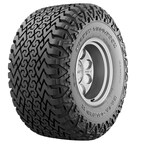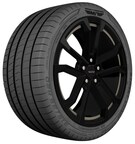AKRON, Ohio, July 29, 2010 – The Goodyear Tire & Rubber Company today reported improved tire unit volumes, higher sales and a net profit in the second quarter of 2010.
"We are very pleased with our strong performance in the second quarter and first half of the year," said Richard J. Kramer, president and chief executive officer. "Our businesses continue to perform better than a year ago as they capture the benefits of recovering industry demand, strong new product performance and solid productivity improvements. We are clearly on the right path as our strategies position us to grow profitably as markets continue to improve."
Kramer noted that improved results in the company’s North American Tire business unit made a significant contribution to Goodyear’s second quarter success. "These results are further evidence of the effectiveness of our strategy to drive innovation, improved mix and operational efficiency in the business," he said.
Goodyear’s second quarter 2010 sales were $4.5 billion, up 15 percent from the 2009 quarter. Second quarter sales reflect the $304 million impact of a 10 percent increase in tire unit volume due to improved global demand. Sales were also positively impacted by $161 million from higher sales in other tire–related businesses, primarily third–party chemical sales in North America, and by improved price/mix. Unfavorable foreign currency translation reduced sales by $37 million.
The company had segment operating income of $219 million in the second quarter of 2010, up from $24 million in the year–ago quarter. Compared to last year, second quarter segment operating income reflects higher global demand, strong price/mix performance and cost reduction actions.
Improved price/mix of $121 million in 2010’s second quarter more than offset $54 million in net higher raw material costs ($89 million before raw material cost reduction actions). Unfavorable foreign currency translation reduced segment operating income by $14 million.
The 2010 second quarter included charges of $8 million (3 cents per share) due to rationalizations, asset write–offs and accelerated depreciation, and $3 million (1 cent per share) for a one–time importation cost adjustment, and a gain of $8 million (3 cents per share) on asset sales. All amounts are after taxes and minority interest.
Goodyear’s second quarter 2010 net income was $28 million (11 cents per share), compared with a loss of $221 million (92 cents per share) in the 2009 quarter. All per share amounts are diluted.
"Raw material costs remain a challenge and we continue to see an uncertain economy, but we remain focused on the proven strategies that have enabled us to address these headwinds over time," Kramer said.
See the table at the end of this release for a list of significant items impacting the 2010 and 2009 quarters.
Business Segment Results
See the note at the end of this release for further explanation and a segment operating income reconciliation table.
| North American Tire | Second Quarter | Six Months | ||
|---|---|---|---|---|
| (in millions) | 2010 | 2009 | 2010 | 2009 |
| Tire Units | 16.6 | 14.8 | 31.8 | 28.7 |
| Sales | $2,049 | $1,687 | $3,828 | $3,231 |
| Segment Operating Income (Loss) | 16 | (91) | 2 | (280) |
| Segment Operating Margin | 0.8% | (5.4)% | 0.1% | (8.7)% |
North American Tire’s second quarter 2010 sales increased 21 percent from last year to $2 billion, reflecting a 13 percent increase in tire unit volume, improved price/mix and branded share gains in the consumer replacement business. Original equipment unit volume increased 69 percent, primarily in the consumer business. Replacement tire shipments were up 2 percent from last year. Sales were positively impacted by $179 million from higher sales in other tire–related businesses, primarily third–party chemical sales.
Second quarter 2010 segment operating income of $16 million was a $107 million improvement over the prior year. Compared to the prior year, price/mix improved $36 million, while raw material costs were essentially unchanged. The 2010 quarter also benefitted from higher volume, increased production levels, decreased pension expense and actions to reduce costs. General and product liability expense increased in the quarter.
| Europe, Middle East and Africa Tire | Second Quarter | Six Months | ||
|---|---|---|---|---|
| (in millions) | 2010 | 2009 | 2010 | 2009 |
| Tire Units | 16.8 | 15.8 | 35.2 | 32.0 |
| Sales | $1,455 | $1,393 | $2,984 | $2,661 |
| Segment Operating Income (Loss) | 73 | (15) | 182 | (65) |
| Segment Operating Margin | 5.0% | (1.1)% | 6.1% | (2.4)% |
Europe, Middle East and Africa Tire’s second quarter sales increased 5 percent from last year to $1.5 billion primarily due to a 6 percent increase in tire unit volume and strong price/mix performance. Original equipment unit volume increased 27 percent. Replacement tire shipments were up 1 percent. Unfavorable foreign currency translation reduced sales by $83 million.
Second quarter 2010 segment operating income of $73 million was an $88 million improvement over the prior year. Improved price/mix of $23 million in 2010’s second quarter more than offset $3 million in higher raw material costs. The 2010 quarter was also positively impacted by higher volume, increased production levels and actions to reduce costs.
| Latin American Tire | Second Quarter | Six Months | ||
|---|---|---|---|---|
| (in millions) | 2010 | 2009 | 2010 | 2009 |
| Tire Units | 5.2 | 4.6 | 10.3 | 8.8 |
| Sales | $529 | $437 | $1,007 | $820 |
| Segment Operating Income (Loss) | 66 | 73 | 142 | 121 |
| Segment Operating Margin | 12.5% | 16.7% | 14.1% | 14.8% |
Latin American Tire’s second quarter sales increased 21 percent from last year to $529 million primarily due to a 13 percent increase in tire unit volume and strong price/mix performance. Original equipment unit volume increased 16 percent, resulting from higher vehicle production. Replacement tire shipments were up 11 percent
Second quarter segment operating income of $66 million was $7 million lower than in 2009 primarily due to a $32 million decline related to events in Venezuela, including the currency devaluation. Improved price/mix of $33 million in 2010’’s second quarter more than offset $24 million in higher raw material costs. The 2010 quarter was also positively impacted by higher volume and increased production levels.
Reflecting a weaker demand environment, events in Venezuela, including the currency devaluation, may adversely impact Latin American Tire’s full-year 2010 segment operating income by more than $75 million as compared to 2009.
| Asia Pacific Tire | Second Quarter | Six Months | ||
|---|---|---|---|---|
| (in millions) | 2010 | 2009 | 2010 | 2009 |
| Tire Units | 5.3 | 4.8 | 10.5 | 8.9 |
| Sales | $495 | $426 | $979 | $767 |
| Segment Operating Income (Loss) | 64 | 57 | 133 | 72 |
| Segment Operating Margin | 12.9%% | 13.4% | 13.6% | 9.4% |
Asia Pacific Tire’s second quarter sales increased 16 percent from last year to $495 million due to a 9 percent increase in tire unit volume with strong replacement market volumes in China and India and favorable foreign currency translation. Original equipment unit volume increased 22 percent, resulting from higher vehicle production. Replacement tire shipments were up 2 percent.
Segment operating income of $64 million increased $7 million over last year and was a second quarter record. Improved price/mix of $29 million in 2010’s second quarter offset $28 million in higher raw material costs. The increase in segment operating income was also due to higher volume and actions to reduce costs.
Year-to-Date Results
Goodyear’s sales for the first six months of 2010 were $8.8 billion, up 18 percent from $7.5 billion in the 2009 period. Sales reflect the $703 million impact of a 12 percent improvement in tire unit volume due to higher global industry demand, as well as a $286 million increase in sales in other tire–related businesses, primarily third–party chemical sales by North American Tire, and by improved price/mix. In addition, favorable currency translation increased sales by $187 million.
The company’s year-to-date segment operating income of $459 million compares to a segment operating loss of $152 million last year. Compared to the prior year, year-to-date segment operating income reflects higher sales and improved profitability in all four of the company’s business units and actions that reduced costs by $281 million.
The 2010 period also benefitted from $122 million in improved price/mix and $229 million in lower raw material costs compared to the first six months of 2009. Raw material costs reflect $73 million in actions taken to reduce their impact.
Goodyear’s year-to-date net loss of $19 million (8 cents per share) compares to a net loss of $554 million ($2.30 per share) in 2009’s first half. All per share amounts are diluted.
Conference Call
Goodyear will hold an investor conference call at 10 a.m. today. Approximately 45 minutes prior to the commencement of the call, the company will post the financial and other related information that will be presented on its investor relations Web site: http://corporate.goodyear.com/en-US/investors.html.
Participating in the conference call will be Richard J. Kramer, president and chief executive officer, and Darren R. Wells, executive vice president and chief financial officer.
Investors, members of the media and other interested persons may access the conference call on the Web site or via telephone by calling (706) 643-2869 before 9:55 a.m. A taped replay will be available later by calling (706) 645-9291. The replay will also remain available on the Web site.
Goodyear is one of the world’s largest tire companies. It employs approximately 70,000 people and manufactures its products in 57 facilities in 23 countries around the world. Its two Innovation Centers in Akron, Ohio and Colmar-Berg, Luxembourg strive to develop state-of-the-art products and services that set the technology and performance standard for the industry. For more information about Goodyear, go to http://www.goodyear.com.
Certain information contained in this press release may constitute forward-looking statements for purposes of the safe harbor provisions of The Private Securities Litigation Reform Act of 1995. There are a variety of factors, many of which are beyond our control, that affect our operations, performance, business strategy and results and could cause our actual results and experience to differ materially from the assumptions, expectations and objectives expressed in any forward-looking statements. These factors include, but are not limited to: our ability to realize anticipated savings and operational benefits from our cost reduction initiatives or to implement successfully other strategic initiatives; increases in the prices paid for raw materials and energy; actions and initiatives taken by both current and potential competitors; deteriorating economic conditions or an inability to access capital markets; pension plan funding obligations; work stoppages, financial difficulties or supply disruptions at our suppliers or customers; a labor strike, work stoppage or other similar event; our failure to comply with a material covenant in our debt obligations; the adequacy of our capital expenditures; potential adverse consequences of litigation involving the company; as well as the effects of more general factors such as changes in general market, economic or political conditions or in legislation, regulation or public policy. Additional factors are discussed in our filings with the Securities and Exchange Commission, including our annual report on Form 10-K, quarterly reports on Form 10-Q and current reports on Form 8-K. In addition, any forward-looking statements represent our estimates only as of today and should not be relied upon as representing our estimates as of any subsequent date. While we may elect to update forward-looking statements at some point in the future, we specifically disclaim any obligation to do so, even if our estimates change.




